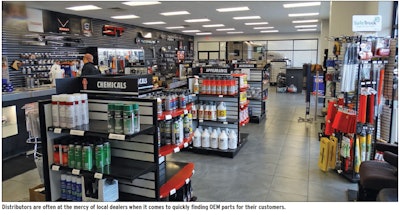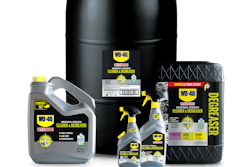The following comes from the August 2017 issue of Truck Parts & Service. To read a digital version of the magazine, please click the image below.

Part of life as an independent aftermarket distributor is the understanding that you can’t have every part for every customer every day. Good distributors stock as much as possible, but without access to everything, the possibility a customer one day requests a part you don’t have is an eventuality.
In these instances, where the options are send the customer away or find another route to serving their needs, independent aftermarket distributors avoiding the former must accept the reality of the latter: that sometimes, the independent aftermarket is reliant on truck dealers.
In a market as competitive as today’s parts industry, that reliance can create uneasiness on both sides. But with a focus on the end user and the importance of fulfilling his needs, independent distributors can forge sturdy relation-ships with dealers that eventually benefit both sides.
“There is intense competition between us and the dealers, but there’s no question we have to rely on them sometimes,” says Midwest Truck Parts President Howard Siegel.
“It’s not something that we have to do daily, but we have to do it. Every company in this industry has to go to competitors because our customers (the fleets) are always in a hurry.”
Taking care of customer needs and building strong working relationships among dealers and distributors set the most successful companies apart from the rest, says Sean Malik, branch man-ager of Action Truck Parts’ Bolingbrook, Ill., location.
“One of the most important things you can do is basically use the Golden Rule,” he says. “Treat customers the way that you would want to be treated. Take care of whatever they need the best you can.”
“One of the biggest things we can do to build a relationship is to be able to make the lives of our customers as easy as possible,” adds Tommy Hill, general manager of Truck Parts of South Carolina.
“If we don’t have it, we have to get it. The real success to any business, especially in this industry, is bending over backwards to give the customer what they need. You have to be available 24/7 and offer them what they need, when they need it. Fleet owners don’t have time to wait around on us. We have to be ready to take care of them as soon as they need it.”
Which means going the extra mile whenever necessary to provide the parts needed. Malik says Action Truck Parts first tries to identify exactly what a customer needs so it knows what it can or can’t get from its suppliers.
“If we receive a call from a customer who needs something, whether it’s an OE or aftermarket part, we can guide them to the best item. Sometimes one part will work for the job, but the service shop just may not be aware of it. We can work with them to find the best fi t so they can complete the job.”
Through these discussions, distributors can uncover parts they may able to source through aftermarket suppliers specializing in previously OEM-exclusive products, as well as all-makes lines found through regular supplier partners that may fulfill an aspect of a customer’s request.
But even with these avenues, there will continue to be times when “dealer only” parts are needed. When that happens, Siegel says there’s no choice but to reach out to the dealerships.
In most cases, however, dealers do not extend special price offering to distributors. After all, dealership service departments are direct competitors to distributors.
“We don’t get price breaks,” Siegel says. “Most of the time we pay the top dollar for any part that we purchase from a dealer.”
He says that building relation-ships with particular counter sales personnel at the dealerships can help ease that at times.
“We try to build relationships with certain counter people be-cause they will help you as much as they can,” Siegel says. “But, they can only do so much.”
Siegel adds that pricing works both ways, however. “There are times when a dealer needs parts from us, but we price the way they would do us.”
Walking the line in building relationships with dealers so they don’t see you solely as competition is not always easy.
According to Southwest Truck Parts Owner Duane Polok, the relationship between dealers and distributors is more strained than it was years ago, but the need to rely on one another has not changed.
“Back in the day, I believe the relation-ships between distributors and dealers were stronger than they are now,” he says. “There are still many that work well with us, but there are some that just don’t want to work with us at all. They see us as competition, which we are. But, there is more than enough business for all of us.”
The main area that Polok believes dealerships hold an advantage is due to technology.
“It seems like we can’t live without the dealers anymore because of the advances in technology,” Polok says, pointing to the sophistication of many parts.
He says his company works with many OEMs, such as Freightliner and Peterbilt, to help strengthen relationships with local dealers.

Polok says that when his company needs a part, they call on the dealers immediately just as a fleet owner would.“We don’t wait until we need several things,” he says. “We have to work with the dealers that can get us what we need when we need it because our customers have to be back on the road.”
Siegel adds that relationships with common vendors also allow distributors to have better access to the parts they need or to the sources at dealerships that can help them most.
It’s also important to remember dealers don’t stock everything, either. Sometimes they can be just as reliant on the aftermarket as it may be on them. Stocking parts a dealer might need for a particular customer is one way to prove your value to them and increase the potential for a cooperative relationship.
“We maintain a close relationship with our truck and trailer dealers in the area since we need them when working on the many differ-ent nameplates we see every day in and out of our service departments,” says Mike Lerach, parts sales manager at Blaine Brothers. “[But] since we are also a capacity dealer, and sell a multiple line of trailers at our North American trailer location, this relation-ship can work both ways.”
He adds, “Not all OEM nameplates are easy to work with but our longevity in this marketplace has helped our parts and service personnel to develop many close working relationships on a day-to-day basis within the local dealer channels.”
Appealing to a dealer’s customer service traits is a helpful tactic, too. No one wants to let a customer down.
“It is all of our jobs to make sure that fleets are on the road and avoid-ing downtimes so the better working relationships we have with our networks, the better off we all are,” says CIT Trucks President Erick Miner.
The best companies are able to meet a customer’s needs at any given time, adds Rick Reynolds, president of Peach State Truck Centers.
“It takes a great deal of teamwork from distributors, suppliers, shop guys, sales people, everyone really, to meet the demands of our industry,” he says. “But those who go the extra mile to do that are the ones who build loyal and consistent customer bases.”









